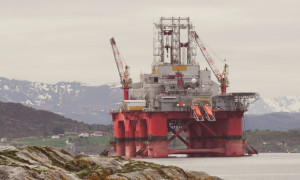Pressure Mounts to Retire Older Fleet as Rig Oversupply Persists
With no signs of a turnaround in global rig demand, drilling contractors are under increasing pressure to retire older rigs. Operators worldwide have succumbed to the prolonged weakness in oil prices by curtailing drilling activities.
An oversupply of rigs in an already slow drilling market combined with the addition of newbuilds to the global fleet, are key factors nudging drilling contractors towards retiring their older fleet.
PRESSURE MOUNTS TO RETIRE OLDER RIGS
According to Rigzone’s RigLogix database, worldwide utilization of rigs, comprising drill barge, drillship, inland barge, jackup, platform rig, semisubmersible, submersible and tender rig, stood at 65.4 percent August 2015, down 12.6 percent from August 2014’s 78 percent as rig demand fell due to oil prices trading around half the level they were in the corresponding period.
Transocean Ltd., a major industry player, disclosed in a May 19 presentation that the “rig market is temporarily oversupplied, including ultra-deepwater,” and the firm added that divestment or scrapping of non-core assets is one part of its strategy to improve fleet quality.
Industry players in Asia, where most new rigs are constructed, are keeping a close watch on the evolving drilling market.
“Older rigs have to be replaced. Ensco, Paragon Offshore and Transocean have already started doing so,” a China-based source, whose firm owns two newbuilds, told Rigzone.
Moreover, the addition of newbuild rigs to the global fleet will encourage “early retirement of older rigs. As you can see, 34 semisubs have already been scrapped since July 2014 because drilling contractors try to cut the active supply, in order to save the day rate,” Pan Xi Lu, marketing manager at Yantai CIMC Raffles Offshore Ltd. (CIMC Raffles) commented to Rigzone.
Weaker day rates have pressured the semisub and jackup segments more than drillships.
First semis, then jackups as there are about 100 semis and about 200 jackups more than 30 years old, but most drillships were built after 2000 and newer rigs will find it easier to get charter contracts,” Pan explained.
In the absence of a turnaround in drilling demand, market watchers expect firms to retire older units as they press ahead with plans to reduce costs and operate a modern and efficient fleet. Maersk Drilling’s Maersk Endurer (350’ ILC) was among the latest rig to be scrapped, with the jackup being shipped to China for recycling.
“We anticipate the scrapping and stacking trend will continue, which will help to improve the supply and demand balance,” David Hensel, senior vice president of marketing at Ensco said April 30 during the firm’s earnings call.
Major rig builders such as Singapore’s Keppel Offshore & Marine Ltd. (Keppel O&M) echoed a similar sentiment.
“Days are numbered for many old rigs … about 94 jackups and 27 floaters around the world are more than 30 years old. The scrapping of old rigs will hasten a rebalance of demand and supply in the offshore market and sow the seeds for the upturn,” Loh Chin Hua, CEO of Keppel Corp. Ltd. – parent firm of Keppel O&M – commented July 23 when announcing the firm’s quarterly results.
RIG STACKING TO EASE PRESSURE ON DAY RATES
Oversupply continues to weigh on day rates despite the retirement of 36 rigs – comprising 4 drillships, 14 jackups and 18 semisubs – this year, according to RigLogix. Rig owners have tried to ease the pressure on day rates by taking rigs – with jackups accounting for around 70 percent of the total – out of circulation, through ready stacked or cold stacked.
According to RigLogix, more jackups have been cold stacked in the Americas due to relative fleet age and market conditions. Meanwhile in areas such as Asia, easy access to quality shipyards makes it more convenient for drilling contractors to idle rigs while they are being marketed for work. Looking ahead, industry sources felt that the degree of global drilling demand would determine whether rigs currently ready stacked would join the cold stacked fleet.
“Eventually it will move there from ready stacked to cold stacked … the main factor are activities by oil and gas companies … some have cancelled program for next two to three years [and] rigs are dependent on oil companies’ expenditure,” Thomas Tan, executive chairman and CEO of Singapore-based offshore and marine services provider Kim Heng Offshore & Marine Holdings Ltd. explained to Rigzone.
Tan was referring to the move by ConocoPhilips Co. to trim its deepwater exploration spending to reduce expenses in a low oil price environment, which led to its cancellation of a three-year contract for newbuild Ensco DS-9 (UDW drillship) to drill in the Gulf of Mexico.
ConocoPhillips chairman and CEO Ryan Lance said July 16 that the company’s “decision to reduce spending in deepwater will further increase our capital flexibility and reduce expenses … strengthens our ability to achieve cash flow neutrality in 2017 even if lower commodity prices persist.”
Chinese rig builder CIMC Raffles also shared the gloomy outlook on an oil price recovery within the next couple of years, believing that more rigs will be cold stacked. “Yes, I think more and more ready stacked rigs will become cold stacked because the ‘low oil price’ will last at least two years,” Pan commented to Rigzone.
Given the negative outlook on a pickup in drilling activities over the next one to two years, rig owners will have to decide on its plans for their cold stacked fleet.
NEWBUILDS BEING READY STACKED
The entry of new rigs to the global drilling fleet, ordered a few years ago, prior to the downturn in oil prices, is also impacting day rates. According to RigLogix estimates as of Aug. 17, 71 newbuilds are scheduled to be delivered this year, comprising 12 drillships, 51 jackups and 8 semisubs. However, given the increasing number of delivery delays, it is highly unlikely those numbers will happen, Terry added.
In the present market downturn, several new rigs have been ready stacked upon delivery from the yard, including six jackups and two drillships – Opus Tiger 1 (mid-water drillship) and Ensco DS-9, which lost its contract with ConocoPhillips recently.
“Ninety five percent of newbuild rigs due for delivery this year are almost complete and owners are trying delay the deliveries,” Tan observed.
“Most of the rigs under construction in China can’t deliver as planned as most of the owners are small speculators and they are now trying to sell the rigs, otherwise they will be acquired by bigger contractors such as Paragon Offshore acquiring Prospector Offshore Drilling S.A. and Shandong Offshore International Co. Ltd.’s acquiring Northern Offshore, Ltd.,” Pan told Rigzone.
Over in East Malaysia, around 80 percent of the ready stacked rigs in Labuan waters are on a standby for contracts, a local source told Malaysian newspaper Daily Express June 8, and rig owners are believed to have paid between $6,000 and $30,000 per month for maintenance and stacking, the source added.
“They are running out of space in Labuan for stacking and Sabah [state] government may impose a tax [for doing so … rig owners are] already not generating cash flow, now they may have to deal with taxes,” Kim Heng CEO Tan said.
Meanwhile, shipyards like CIMC Raffles are going beyond their primary roles as rig builders as seen in recent transactions involving the sale of the two newbuild jackups.
“CIMC tries to help our customers find charter contracts or sell the rigs … we helped Coastal Contracts to sell a delivered Ju2000E [Kan Tan VII (400’ ILC)] to Sinopec [China Petrochemical Corp.],” Pan revealed.
He added that CIMC also assisted China National Petroleum Offshore Engineering Co., Ltd. (CPOE) to “get a Super M2 [jackup] through finance lease: we sold the rig to Mingsheng Financial Leasing Co., Ltd., Mingsheng Leasing then chartered the rig to CPOE, this rig left our yard in June.”
Fuente: http://www.rigzone.com
 Fianzas y Seguros CRYA
Fianzas y Seguros CRYA

